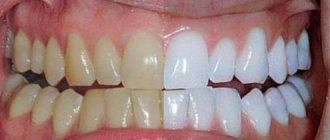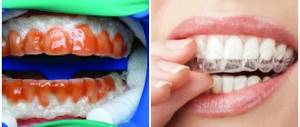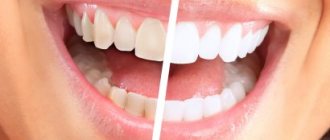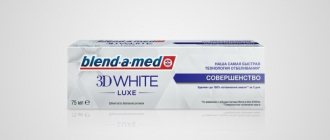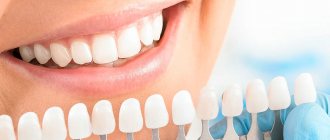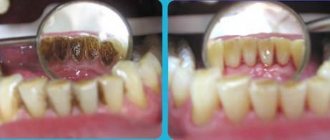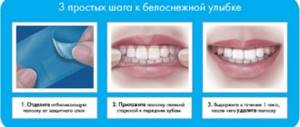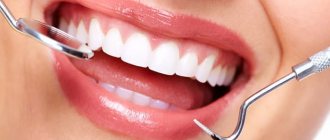Author: Brodsky Sergey Evgenievich Deputy Chief Physician, Candidate of Medical Sciences in the specialties: dentistry and medical microbiology Taking into account possible complications, safe teeth whitening is of interest to a huge number of potential consumers of this dental service. What is gentle and safe teeth whitening at the dentist can be found in this article.
- Is teeth whitening safe?
- Safe teeth whitening at the dentist
- What is the safest and most effective teeth whitening?
- Gentle teeth whitening
- Benefits and harms of teeth whitening
Do it yourself or dentistry at home
It would seem that it has long been clear that procedures related to one’s own health are best left to professionals. After all, in the end, going to a doctor will be the most economical way both in terms of time and costs. Self-medication, at a minimum, does not lead to the desired results, and in the worst case scenario, it creates new problems, the elimination of which will require both time and money.
To whiten teeth at home, specialized toothpastes are used, as well as whitening strips and pencils. However, in most cases, the effect of use is minimal or absent altogether. The reasons for this lie in the fact that the recommendations for the use of these products specified in the accompanying manuals do not take into account many factors - such as age, dental condition, the presence of dental defects or chronic diseases, as well as inflammatory processes. Not to mention that many people prefer not to read any instructions at all. The result can be disastrous - without solving one problem, you will acquire new ones in the form of specific complications.
Even if you carefully follow all the instructions, avoid products that promise a miracle effect in just a day or hour. Such technologies simply do not exist! The trick of some unscrupulous manufacturers may come down to the inclusion of a dye in the composition. As a result, your teeth will actually turn white for a short time, but after the first brushing or a couple of meals, all the whiteness will quickly disappear.
In a situation where the problem is not so significant, the most reasonable action would be to consult a dentist, who will be able to prescribe medications for home use in accordance with an individually developed program. In more complex cases, whitening should be done in the dentist's office.
How to choose a teeth whitening method
The dental whitening procedure can be performed at home or in a dental clinic.
The methods and results differ significantly. For home whitening, as a rule, folk remedies or acid preparations are used, which negatively affect the enamel and sensitivity of teeth. Dentists do not recommend performing the procedure at home, especially if we are talking about a child, since the risk of negative consequences is too great (increased sensitivity of teeth, damage to enamel, destruction of the crown, etc.). What is the safest and most effective teeth whitening? Considering the characteristics of tooth enamel in children, aggressive methods should be immediately excluded. Dentists recommend choosing enamel lightening procedures that result in a change in the color of the crown up to 2-3 tones and do not involve the action of acids.
The method of correction depends on the characteristics of the teeth, the initial state of the enamel, the age of the patient and the expected result. The smaller the child, the more gentle the procedure should be. Teenagers who have already had a change of teeth can resort to more effective methods.
Safe teeth whitening with dental products
If you decide to have professional whitening, already at your initial appointment with a dentist you will be told in detail about the available methods - depending on the chosen one, the cost will differ. The most popular types of whitening: laser, chemical, ultrasound, photodynamic, as well as one of the most modern and promising methods - Zoom technology. It is on its analysis that we will dwell in more detail.
Zoom 4 is the name of the latest (in terms of appearance) generation of this whitening technology. Its essence lies in the use of a special gel, the active components of which ensure the penetration of oxygen molecules deep inside the tooth under the influence of ultraviolet radiation. This leads to qualitative changes and long-lasting results. In one session it is possible to lighten the enamel by more than 10 tones.
Initially, this whitening technology came to Russia from overseas, but due to its high efficiency it quickly gained recognition in most European countries. With each generation, technology improves and becomes safer. The last factor is fundamentally important, since some of the criticism at the beginning (when Zoom first appeared) related to the generous use of hydrogen peroxide, which, as you know, is not the best friend of tooth enamel. At the moment, its content in the treatment system is no more than 25 percent. An important advantage of the system is that all its components are produced by one manufacturer, which guarantees their full compatibility. At the same time, it effectively fights not only the natural pigmentation of teeth, but also darkening caused by active coffee consumption and bad habits. It is important that whitening occurs without damaging teeth or causing microcracks.
Whitening methods
Teeth whitening methods are divided into chemical and mechanical, although many of them combine both elements. Chemical whitening involves the use of pastes, gels and other substances that remove years and lighten the enamel. But such procedures have a noticeable negative effect on teeth, unlike laser or sonic methods. The best whitening for each person is a method that in his case has no contraindications and does not cause pain, so in each specific case the patient himself chooses what is right for him.
Laser whitening
With this method, the main bleaching component is hydrogen peroxide, and a laser is used to enhance the properties of this composition, while under the influence of the light flux, the peroxide penetrates faster into the surface of the enamel without destroying its outer layer.
Laser teeth whitening
Frequent laser whitening damages enamel, and although such whitening occurs within half an hour, and the results last up to five years, people with a lot of fillings and poor dental health are advised to choose other alternative whitening methods.
Ultrasonic whitening
The essence of ultrasonic whitening is the effect of ultrasound on the enamel, during which dirt particles are peeled off, and then such particles are removed using a water jet. Unlike most other methods, ultrasound allows you to reach hard-to-reach areas.
Ultrasonic teeth whitening
But patients may experience pain when treating carious teeth and inflamed gums. Another disadvantage of the method is that the end result is hardly noticeable in people with teeth darkening several shades. This is due to the fact that technically this method is not so much bleaching as a thorough cleaning, in which the effect on the color of the enamel is minimal.
Whitening gels and strips
Such products can be used for whitening at home, but it is better to entrust these procedures to specialists. Most gels are made with hydrogen peroxide, which lightens the enamel. In the composition of such products, the negative destructive effect of peroxide is neutralized due to the activity of other components, so the use of gels for sensitive teeth is allowed.
Whitening strips
There are three ways to use such compositions:
- use in mouthguards that are pre-made individually (such devices must be worn at night or worn for several hours during the day);
- application to the surface of the teeth with a brush;
- Use after toothpaste when brushing your teeth.
But this method has more disadvantages than advantages, and among them is the possibility of developing allergic reactions to the components of the gel, having a destructive effect on unclosed carious areas and microcracks, burns of the mucous membranes of the esophagus and larynx if the product is accidentally swallowed, and possible irritation of the mucous membranes themselves.
Special strips for teeth whitening are safer in this regard: these are small plates coated on the inside with a whitening compound. The “range” of action of the strips is relatively low: whitening is possible within four tones.
Instructions for applying whitening strips
The main active whitening component of the strips is urea or hydrogen peroxide, covered with a protective layer. After its removal, the layer begins to actively produce bleaching substances during contact with oxygen. You can use this product 1-2 times a day, depending on the product model. The duration of use also depends on the type of strips: the procedure can last from several minutes to half an hour, and during this time you cannot talk, eat, drink or smoke. After removing the strips, you should brush your teeth and rinse your mouth well.
The duration of use of such strips usually does not exceed one month; if the product is used correctly, the destructive effect on the enamel is minimal, and the procedure itself is completely painless. But if the strips are applied incorrectly to the teeth or possible displacement will lead to uneven whitening in different areas, in addition, with increased sensitivity of the teeth and gums and the active component of the strips, as well as in the presence of dental diseases, painful sensations may occur. Depending on the reasons for the darkening or yellowing of the enamel, different effects can be achieved, and in most cases people are not very happy with the result.
In general, such strips can only be recommended for those who have darkening - not too much and occurs due to drinking a lot of coffee and smoking.
Air Flow technique
In fact, the Air Flow method is not whitening, but a method of cleaning teeth with a stream of high-pressure air. During this treatment, plaque and stones are removed and the enamel surface is moderately polished.
Air Flow technique
It is impossible to achieve noticeable lightening (by more than one tone) using this method, and it is not advisable to use this method to lighten enamel, although an air stream is a good way to clean tartar and deposits on teeth.
Whitening at home
Whitening at home can be done using the following products:
- tea tree oil;
- hydrogen peroxide;
- soda;
- Activated carbon;
- special whitening toothpastes containing polishing abrasives and an increased amount of soda;
- whitening pencils equipped with small LED lamps.
Whitening at home
When bleaching at home, you can never guarantee a positive result; in addition, the person himself may not calculate the dosage of the drug, and if it is reduced, the effect will be completely absent, and if it is exceeded, the bleaching agents can have a destructive effect on the enamel.
This is the most dangerous method of restoring the color of teeth, which is not recommended to be used regularly.
Photo whitening Zoom
The best way to whiten teeth from a dentist's point of view is photo whitening using Zoom technology. The method involves the use of a gel containing hydrogen peroxide, and an ultraviolet lamp is used to activate the processes. In practice, this method is similar to conventional chemical whitening, but thanks to the use of a special composition, teeth can be lightened by 10-12 tones (other methods do not guarantee this range).
Before and after Zoom whitening
The benefits of Zoom whitening include:
- duration of effect;
- the ability to perform complete whitening in just one procedure;
- no pain;
- working with hard-to-reach areas;
- no negative impact on the oral mucosa.
Before using this cleaning method, the specialist removes tartar and plaque using the “Air Flow” method, after which the gums and mucous membranes are protected by applying special solutions and installing a cofferdam. The lower part of the face, which may be exposed to ultraviolet radiation, is covered with medical napkins, and protective glasses are put on the patient's eyes.
Protective glasses for Zoom whitening
Next, a whitening gel is applied to the teeth using a special brush, which is activated by exposure to ultraviolet light. During such exposure, the bleaching composition releases active oxygen, which penetrates the enamel and has a whitening effect.
This procedure takes no more than fifteen minutes, and if the change in the shade of the teeth is not very strong, you can get by with one visit to a specialist. But on average, to achieve maximum results, the procedure should be repeated up to four times.
After bleaching, the insulating and protective materials are removed, and the patient is required to rinse his mouth and brush his teeth.
This type of whitening has no restrictions on subsequent food intake: you can eat immediately after leaving the dentist’s office.
Zoom 4 – safe whitening mechanism
Initially, using a special scale, the doctor determines the existing color shade of the tooth enamel. The next step is protective treatment of the oral cavity. Finally, the initial application of the whitening composition to the front teeth (5 upper and 5 lower) occurs. After this, a hardware targeted effect occurs on the treated teeth using a lamp that produces ultraviolet radiation for 10-15 minutes. The protective treatment of the soft tissues of the mouth mentioned earlier is intended for this purpose. Special glasses are used to protect the patient's eyes. Then the gel is applied two more times and the procedure is repeated. Thus, the time spent at the dentist is no more than one hour.
One session will allow you to enjoy a charming smile for more than one year, and, compared to the previous generation, with Zoom 4 the effect lasts up to 25 percent longer (up to 7 years, subject to strict adherence to the doctor’s recommendations).
Pros and cons of types of teeth whitening
Photobleaching
- Instant results.
- Uniform impact.
- The duration of the session is no more than an hour.
- Whitening by 8 – 10 tones.
- The occurrence of tooth sensitivity during and after the procedure.
Laser whitening
- Instant results.
- No discomfort during the procedure.
- Maintaining the acid balance of the oral cavity.
- Strengthening enamel.
- Whitening by 12 tones.
- The duration of the session is more than an hour.
- Uneven teeth whitening.
- High price.
Chemical bleaching
- Instant results.
- Uniform impact.
- Acceptable price.
- Simplicity of the procedure.
- Whitening by 5 – 7 tones.
- The occurrence of tooth sensitivity during and after the procedure.
- The need for several sessions.
In-canal whitening
- Local effect on tissue.
- Painless.
- Whitening by 5 – 7 tones.
- Weakening of dental tissues.
- Prohibition on repeating the procedure.
Whitening on trays
- Affordable price.
- Possibility to use the mouth guard at any time.
- Whitening by 5 – 8 tones.
- The duration of the course is 1 month.
Lightening strips
- Visible effect after the third application.
- Affordable price.
- Whitening by 3 – 5 tones.
- Inconvenient to use.
- The duration of the course is 1 month.
Varnish or pencil
- Ease of use.
- Minimum costs.
- Lightening by 1 - 2 tones.
- Poor efficiency.
Contraindications for teeth whitening and recommendations
First of all, we note that the whitening procedure using the Zoom 4 method (and most alternative methods) is possible only in the absence of inflammatory diseases of the oral cavity, teeth, as well as caries of all stages. Whitening in this way is impossible in the presence of cancer and mental illness, in case of pregnancy, as well as during breastfeeding and at the age of less than 16 years. As with any medical intervention, prior consultation and diagnostic testing are required to identify possible allergic reactions.
To maintain the results achieved during whitening, you will need to carefully monitor oral hygiene, regularly brush your teeth (and use dental floss after meals), and reduce the consumption of drinks containing aggressive natural dyes (coffee and strong black tea). In the first two weeks, you need to refrain from foods containing both synthetic and natural dyes (this list includes certain vegetables, fruits and berries, sauces and sweet sodas). Smoking should be resolutely abandoned - it can quickly reduce the efforts made to zero. Remember that although the Zoom 4 procedure is safe, it is not recommended to do it regularly - otherwise it will lead to deterioration of the enamel and the appearance of cracks on it.
Recommendations from experts
Before whitening, you must contact your dentist for a consultation and determine all the nuances of the upcoming procedure.
Recommendations from dentists.
- Pre-cure all existing dental diseases.
- Children should have their teeth professionally cleaned from the age of two, twice a year.
- To maintain results longer, adhere to some dietary restrictions.
It is not always necessary for a child to whiten his teeth to a snow-white color; in most cases, it is enough to carry out professional hygienic cleaning, which will give the effect of lightening and polishing the enamel. The procedure, first of all, must be safe, so the choice of teeth whitening method should be entrusted to the dentist.
Prices for teeth whitening in Krasnoyarsk
So, let's summarize. Whitening is a safe procedure that almost every patient of our clinic can afford. We know that this is not always easy to decide on, so we regularly organize promotions for effective whitening procedures.
What to expect? A comfortable 30 minutes with a doctor and lightening the enamel up to 10 shades on the Vita scale. We recommend that you get acquainted with it in advance on the Internet. It is divided into many shades, taking into account the natural differences in the enamel of different people. 10 shades is a visible difference, but you should not expect the effect of a Hollywood smile after the first session. Start with a consultation to understand how many treatments will be needed in your case and what the approximate results will be after each whitening.
The most accessible procedure is Zoom QuickPro, and at the same time it is the safest. There is a low concentration of peroxide in the composition, so you can start your journey into studying the issue of whitening with QuickPro.
Teeth whitening: harm or benefit?
The yellow color of teeth does not in any way affect their health, so whitening is a purely aesthetic procedure. To the question “Is whitening harmful?” the answer is given in the article, but as for the benefits, they certainly exist. A snow-white Hollywood smile allows us to look good, smile freely and feel a little happier.
Considering all of the above, it can be argued that any professional teeth whitening is safe, be it photobleaching, laser, chemical or endodontic, but only when it is carried out with the direct participation of a dentist. That is why it is so important to take a responsible approach to choosing a clinic and a doctor and entrust the beauty and health of your teeth only to reliable and competent specialists.
What is tooth sensitivity?
Increased sensitivity of tooth enamel or hyperesthesia manifests itself in the form of unpleasant sensations that occur when teeth are exposed to irritants such as cold or hot drinks, sweets and others. A reaction to irritants occurs if there is various damage to the tooth enamel in the form of cracks, chips or thinning. Through such damage, the irritant penetrates the nerve structures of the tooth, resulting in unpleasant sensations of varying intensity. General pathologies, such as metabolic disorders, can also affect tooth sensitivity.
Advantages of professional teeth whitening
Experienced specialists work in specialized dental centers. Today, clinics are introducing innovative techniques that guarantee impeccable results. Dentists will be happy to advise and tell you whether teeth whitening can be performed in your particular case without causing harm to the enamel and gums.
Lightening of the elements of the chewing system is carried out in cases where the patient has healthy teeth and does not have crowns or implants. Before starting the procedure, it is necessary to conduct an examination of the oral cavity, if necessary, remove plaque and tartar, and then begin lightening. Cleaning using professional equipment will restore beautiful and impeccable whiteness for a long time. An integrated approach using special chemical gels

